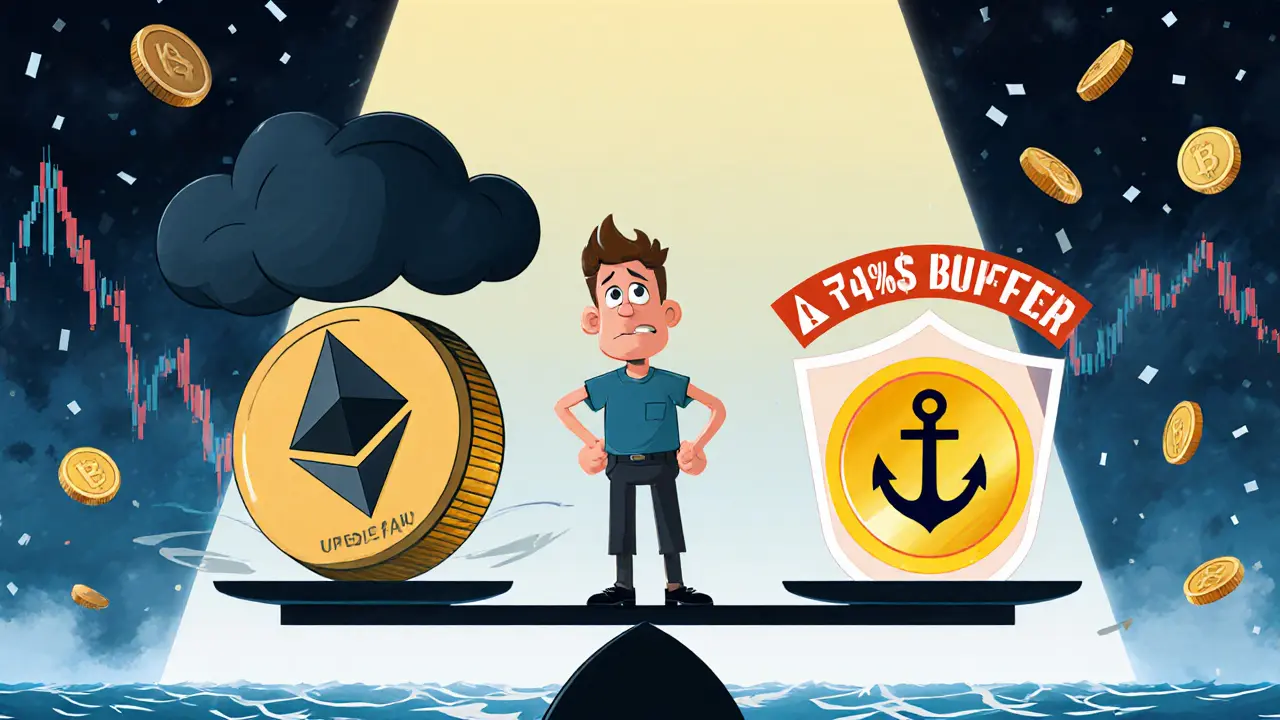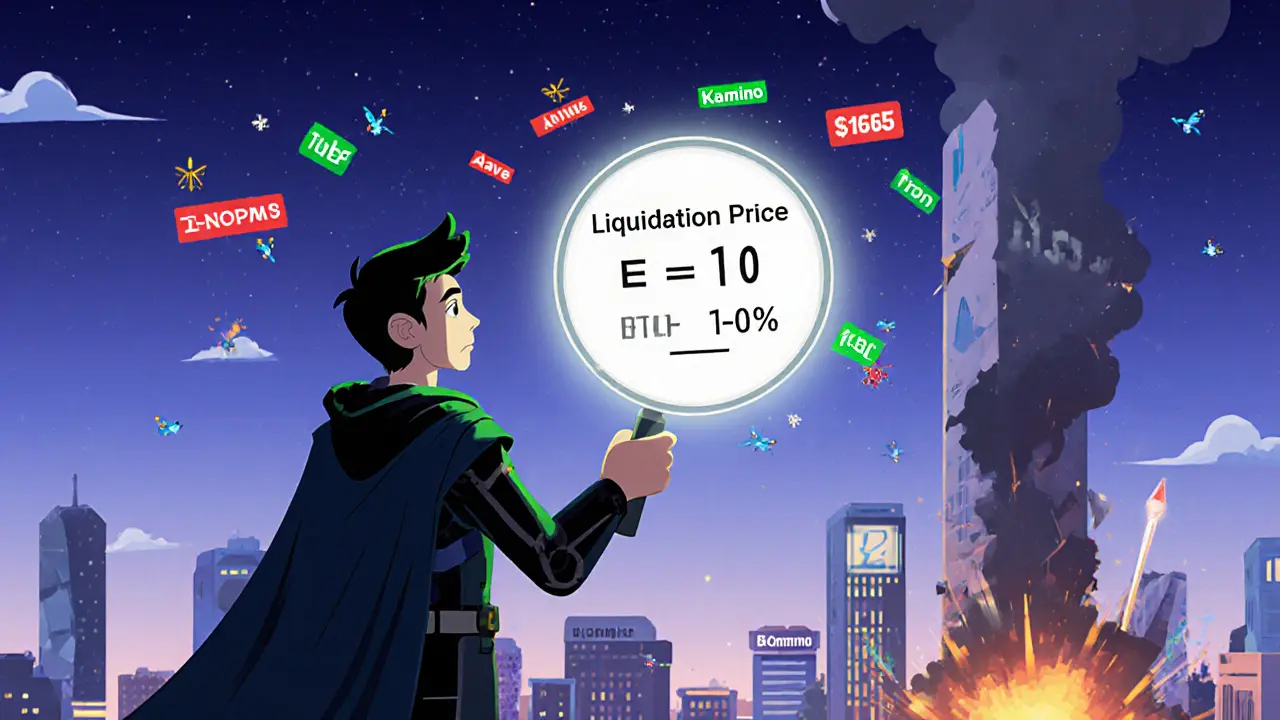 Oct, 4 2025
Oct, 4 2025
DeFi Loan Liquidation Risk Calculator
Calculate your safe borrowing limits and avoid liquidation by inputting your loan details. This tool uses the same methodology described in the article to show you how much buffer you need to stay safe during market volatility.
Your Liquidation Price
Current LTV
Required Buffer
Risk Level
Your position is safe with a healthy buffer.
Recommended Action
Platform-Specific Advice
For USDC collateral on Aave: You can safely borrow up to 90% LTV with minimal risk.
Choosing the right collateral for a DeFi loan isn’t about picking the crypto with the highest price. It’s about understanding risk, timing, and how your assets behave when markets turn sour. If you’ve ever seen your position get liquidated after a 10% drop in ETH or SOL, you know this isn’t theoretical. In 2025, with over $92 billion locked in DeFi lending protocols, the difference between keeping your assets and losing them comes down to one thing: how you pick your collateral.
Why Overcollateralization Isn’t Optional
Every DeFi loan requires you to lock up more value than you borrow. This isn’t a suggestion-it’s a rule built into the code. If you want to borrow $100, you’ll need to deposit at least $110 to $200 worth of crypto. Why? Because prices swing. A sudden drop in your collateral could leave the loan undersecured, and the protocol has to protect lenders. That’s where liquidation comes in.Most platforms use a loan-to-value (LTV) ratio to determine how much you can borrow. For example, if ETH has a 75% LTV, you can borrow up to $75 for every $100 of ETH you deposit. The rest? That’s your safety buffer. But here’s the catch: that buffer isn’t always enough.
Take Kamino Finance on Solana. SOL has a 75% LTV and an 80% liquidation threshold. That means if your LTV hits 80%, your position gets wiped out. Sounds safe? Not if SOL drops 15% in two hours. One Reddit user lost 8.2 SOL because they thought a 2% buffer was enough. It wasn’t. The market moved faster than their dashboard.
Stablecoins Are Your Best Friend
Not all collateral is created equal. Stablecoins like USDC, DAI, and USDT are the most reliable. Why? Because their value doesn’t swing. Most platforms give you the highest LTVs for them-up to 90% on Kamino and 85% on Aave. That means you can borrow more without risking liquidation.During the September 2025 Bitcoin crash, borrowers who used only ETH or SOL saw their positions get wiped out. Those who mixed in USDC? They stayed afloat. One user on r/defi shared that using a 60/40 split of ETH and USDC on Aave kept their loan alive while others lost everything. That’s not luck-it’s strategy.
Stablecoins also react faster to price changes. Oracle feeds (the systems that report asset prices) are more accurate for stablecoins. That means fewer delays, fewer false liquidations, and less stress.
Volatility Changes Everything
High-volatility assets like SOL, AVAX, or meme coins might look tempting because they’re cheap and you can deposit a lot of them. But they’re risky. Aave reduced ETH’s LTV from 77% to 75% in August 2025 after Gauntlet Network flagged rising volatility. Kamino gives SOL a 75% LTV-lower than USDC’s 90%. Why? Because it’s more likely to crash.Here’s a rule of thumb: the more volatile the asset, the lower your LTV and the higher your buffer needs to be. If you’re using SOL, don’t push your LTV past 65%. Even then, keep at least 15% below the liquidation threshold. Gauntlet’s data shows 68% of liquidations happen within 5% of the threshold-often because users ignore price feeds during off-hours.
And don’t forget correlation. If all your collateral is tied to Ethereum or Solana, a network-wide dip can wipe you out. In August 2025, borrowers using only ETH saw 43% more liquidations than those with diversified portfolios that included stablecoins. Diversify your collateral, even if it means borrowing less.

Platform Differences Matter
Not all DeFi lenders play by the same rules.- Aave supports 30+ assets across 15 chains. Its LTVs range from 55% for SHIB to 80% for USDC. It’s the most flexible, but also the most complex. Health factor calculations can confuse beginners.
- Compound uses isolated markets. Each asset has its own pool. USDC has a 75% LTV, ETH has 70%. This reduces systemic risk-if one asset crashes, it doesn’t drag down others. But if ETH’s price feed glitches, you could get liquidated even if your collateral is technically safe.
- Morpho connects borrowers and lenders directly. It can offer up to 82% LTV for stablecoins, but only if there’s enough liquidity. It’s great for efficiency, but risky if the market dries up.
- JustLend (on TRON) offers high LTVs-up to 80% for TRX-but it’s tied to one chain. When TRON went down in May 2025, 12% of loans got liquidated because the network couldn’t process updates.
- Kamino is the go-to for Solana users. 90% LTV on USDC, 75% on SOL. But its liquidation penalty scales from 2% to 10% depending on your health factor. That means the closer you are to liquidation, the more you lose.
Choose the platform based on your assets. If you hold mostly Ethereum tokens, go with Aave or Compound. If you’re deep into Solana, Kamino makes sense. But don’t spread yourself thin across chains unless you know what you’re doing.
How to Avoid Getting Liquidated
Liquidations aren’t random. They happen because people don’t monitor their positions. Here’s how to stay safe:- Calculate your liquidation price manually. Don’t trust the dashboard during a crash. Use this formula: Liquidation Price = (Collateral Amount × Liquidation Threshold) ÷ (Debt Amount × Price). For example: You deposited 1 ETH ($3,000), borrowed $2,100 (70% LTV), liquidation threshold is 75%. Your liquidation price is (1 × 75%) ÷ (2100 ÷ 3000) = $1,071. If ETH drops below that, you’re gone.
- Set alerts. Use free tools like DefiLlama Alerts or EigenPhi. Get notified when your LTV hits 70% or your collateral value drops 10%. Most liquidations happen between 2-5 AM UTC-when you’re asleep.
- Maintain a 15-20% buffer. If the liquidation threshold is 80%, aim to keep your LTV at 60-65%. That gives you room to breathe during volatility.
- Don’t use meme coins. SHIB, DOGE, PEPE-most platforms won’t even let you use them. If they do, the LTV is 30% or less. Not worth the risk.
- Update your collateral regularly. If your ETH price drops, add more. If it rises, you can borrow more. Treat your loan like a live position, not a set-and-forget.

What’s Changing in 2025-2026
DeFi is getting smarter. Aave’s V4, launching in Q1 2026, will adjust LTVs automatically based on real-time volatility. Compound’s new ‘Comet Pro’ will freeze liquidations during extreme market swings-fixing the September 2025 disaster where over 1,200 people got liquidated because of a lagging price feed.MakerDAO is introducing AI-driven risk scoring for new collateral types. And 23% of new DeFi protocols in Q4 2025 are starting to accept tokenized real-world assets-like bonds or real estate-as collateral. But the SEC has already cracked down on two of them. Regulatory risk is rising.
The smartest users now track more than just LTV. They monitor health scores, oracle reliability, and cross-chain bridge risks. Protocols with flexible, dynamic risk controls have an 85% chance of surviving a major crash. Those with aggressive LTVs? 60% more likely to fail.
Final Rule: Know Your Limits
The biggest mistake new borrowers make? Thinking they can borrow more because the platform lets them. It’s not a gift-it’s a trap. The higher your leverage, the closer you are to the edge.University of Zurich’s 2025 study of 12 million loans found that borrowers who kept their collateralization above 160% had 89% fewer liquidations during 10%+ price drops. That means if you borrow $100, deposit $160+ in collateral. It’s conservative. It’s boring. But it works.
DeFi loans give you access to liquidity without selling your crypto. That’s powerful. But power comes with responsibility. Choose your collateral like a trader, not a gambler. Monitor like a banker. And never, ever assume the platform will save you.
What’s the safest collateral for a DeFi loan in 2025?
USDC and other major stablecoins are the safest. They offer the highest LTVs (up to 90%) and the lowest liquidation risk because their value stays stable. Platforms like Aave, Kamino, and Compound all give better terms for stablecoins than for volatile assets like ETH or SOL.
Can I use multiple types of collateral in one loan?
Yes, on platforms like Aave and Morpho. Mixing USDC, ETH, and stETH reduces your overall risk because not all assets crash at the same time. A diversified collateral portfolio can cut your liquidation risk by up to 40%, according to user data from DeBank’s 2025 survey.
What happens if my collateral value drops suddenly?
Your loan’s health factor drops. If it falls below 1 (or the protocol’s liquidation threshold), your collateral is automatically sold to repay the loan. This can happen within minutes during a flash crash. That’s why you need alerts and a buffer-don’t wait until the dashboard turns red.
Are DeFi loans safer than traditional loans?
They’re different. There’s no credit check, but you risk losing your crypto if the market moves against you. Traditional loans have interest rates and repayment schedules. DeFi loans have liquidation risks and oracle delays. Neither is inherently safer-it depends on your discipline and risk management.
How often should I check my DeFi loan position?
Check daily during normal markets. During volatility-like a Bitcoin crash or Fed announcement-check every 2-3 hours. Most liquidations happen when users are offline. Set up automated alerts so you don’t have to watch your screen 24/7.
Is it possible to get liquidated even if my LTV is below the threshold?
Yes. If the price oracle delays or fails-like during the September 2025 ETH feed outage on Compound-you can get liquidated even if your position is technically safe. That’s why you need a buffer and why platforms like Aave now use faster price feeds (Chainlink Fast Price Feeds) to reduce this risk.
Next Steps: What to Do Today
If you’re new to DeFi loans: Start with a small loan using USDC as collateral. Borrow only 50% of your deposit. Set an alert at 65% LTV. Watch how your position behaves over a week. Then try adding ETH at 60% LTV. Learn before you scale.If you’ve been liquidated before: Rebuild with a 160%+ collateralization ratio. Use at least two types of collateral. Avoid Solana and TRON if you’re not comfortable with chain-specific risks. And always, always calculate your liquidation price manually.
DeFi loans are powerful-but only if you treat them like a high-stakes game where the house always wins if you’re unprepared.